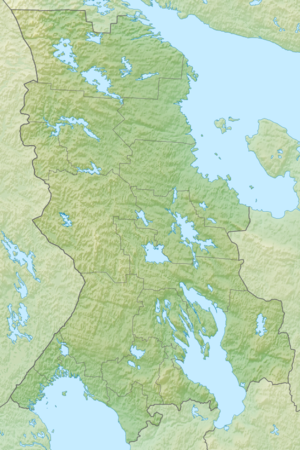Suavjärvi
|
Suavjärvi Suavjarvi |
||
|---|---|---|
| Geographical location | Republic of Karelia , Russian Federation | |
| Drain | → Eningilampi → Seletskoye Lake → Luzhma → Segosero | |
| Location close to the shore | Medvezhyegorsk | |
| Data | ||
| Coordinates | 63 ° 7 '15 " N , 33 ° 22' 35" E | |
|
|
||
The Suavjärvi is a lake in Karelia . It lies in the center of a suspected meteorite crater .
etymology
The name Suavjärvi (also Suavjarvi) comes from Karelian and is circumscribed in Russian as Суавъярви . Järvi means “lake”.
location
The Suavjärvi is located about 50 kilometers northwest of the city of Medvezhjegorsk in the Republic of Karelia . The lake, about 3 kilometers wide, lies in the center of a circular crater structure .
description
The meteorite crater has a diameter of 16 kilometers. Its age is estimated at 2,400 million years BP , so it comes from the Siderium . Not much has been preserved of the meteorite crater itself. Large blocks of impact breccia were found - evidence of the destructive force of the impact on the Baltic Shield .
geophysics
The distinctly circular photoanomaly can also be recognized geophysically as an anomaly of gravity and magnetic fields . For example, it forms a negative Bouguer anomaly, the values of which are 10 milligals lower than the surrounding terrain .
geology
Suavjärvi is located in the archaic basement mountains of Karelia, which here consist of strongly fissured, granitic gneiss and shale . In the Paleoproterozoic , plagiogranites and microclinic granites invaded the Archean. After the impact event, the region was affected by an amphibolite facies metamorphosis ( epidote- amphibolite facies). Then, around 2,300 million years BP, the basic conglomerates of the Jatulium transgressed across the leveled basement.
Impact breccia
The impact breccia is now only exposed in two places 2 to 3 kilometers from the crater rim. It leads basement fragments in the centimeter to hundred meter range.
Structures of shock wave metamorphosis
According to Mashchak and Orlova, examined minerals in large impact breccia blocks show the following stresses:
Cleavage, block formation, deformation twins, deformation bands and planar elements in quartz , microcline and graphite . The quartz grains show planar elements ( Engl. Planar deformation fearures or abbreviated PDF ) in eight different crystallographic orientations. The micro clinker grains also have PDFs with up to four different spatial orientations per individual grain. The PDFs are reliable indicators of shock wave metamorphosis.
meaning
Suavjärvi is possibly the oldest known meteorite crater on earth.
Follow-up examination
In a one-week follow-up examination in 2012, Huber, among other things, could not find any impact breccia or PDFs in the samples they had taken. They therefore do not recognize the Suavjärvi structure as a meteorite crater for the time being and recommend a renewed examination of the original thin section material.
Individual evidence
- ↑ a b M. S. Mashchak, MV Naumov: The Suavjarvi Structure: An Early Proterozoic Impact Site on the Fennoscandian Shield . In: Lunar and Planetary Science . tape 27 , no. 3 , 1996, p. 825-826 .
- ↑ MS Mashchak, JV Orlova: Meteoritika . tape 45 , 1986, pp. 137-141 .
- ↑ MS Huber, among others: Oldest Impact Structures on Earth - The Case Study Of The Suavjärvi Structure (Russia) . In: Large Meteorite Impacts And Planetary Evolution . tape V , 2013.

